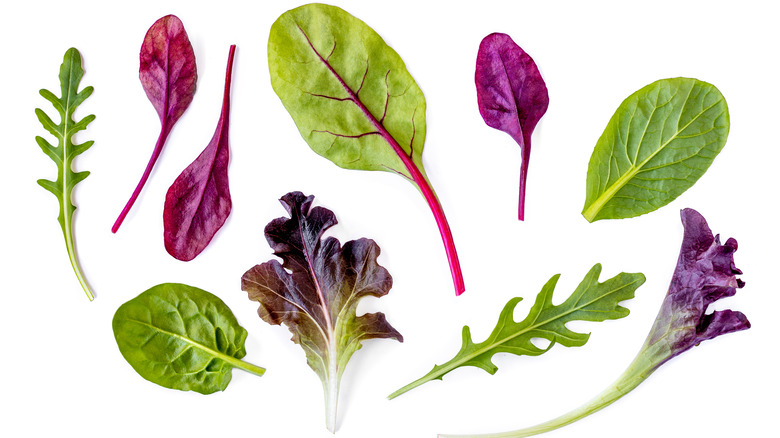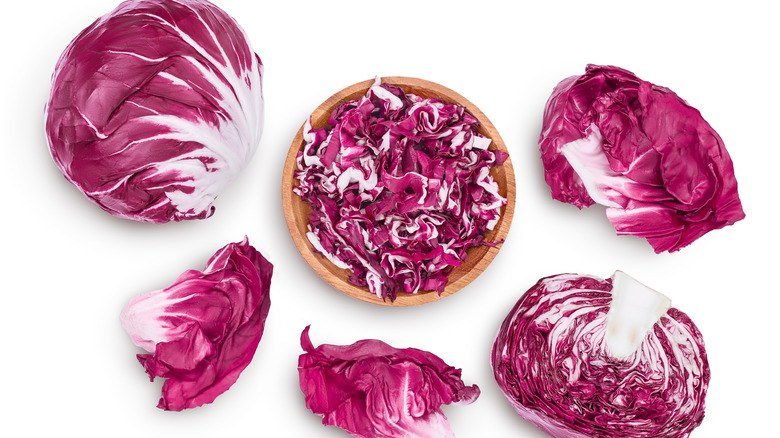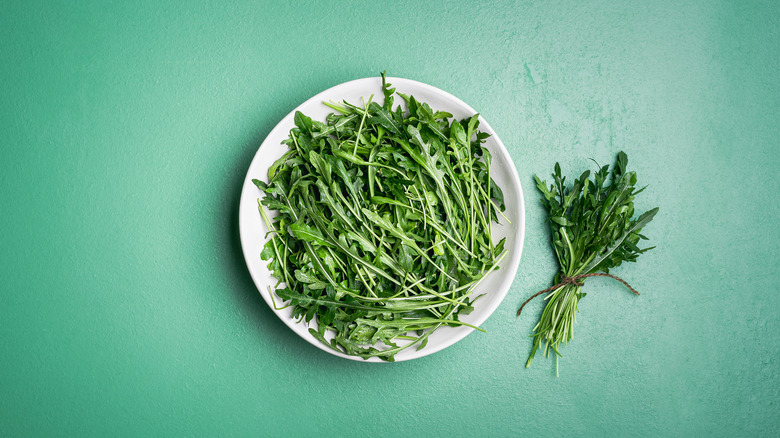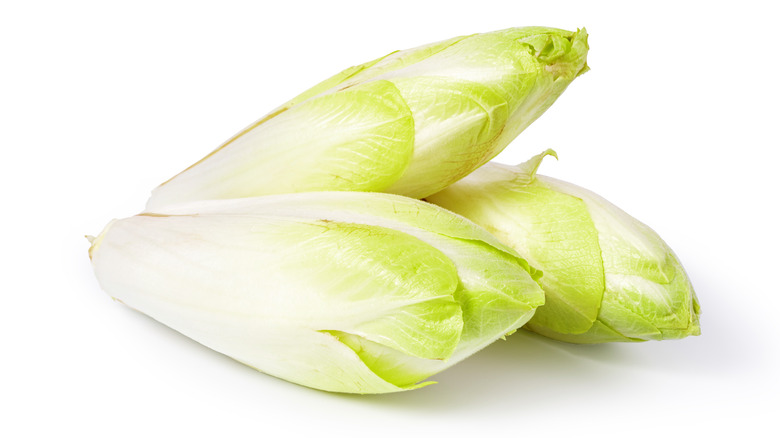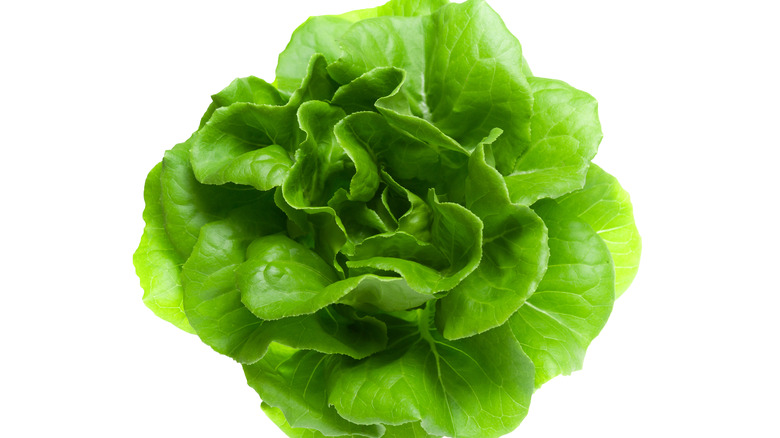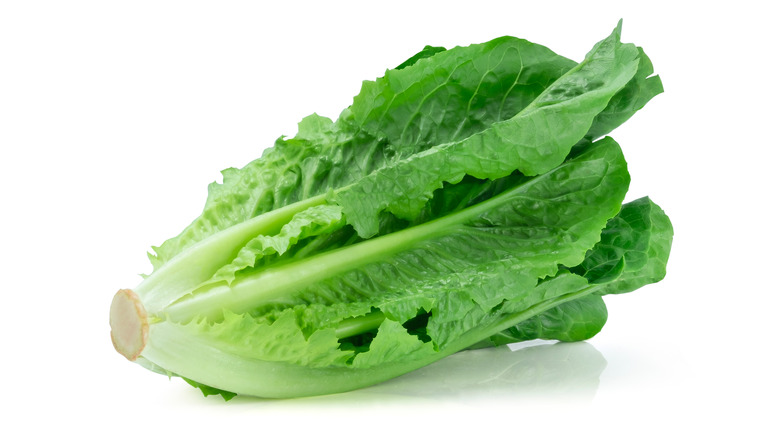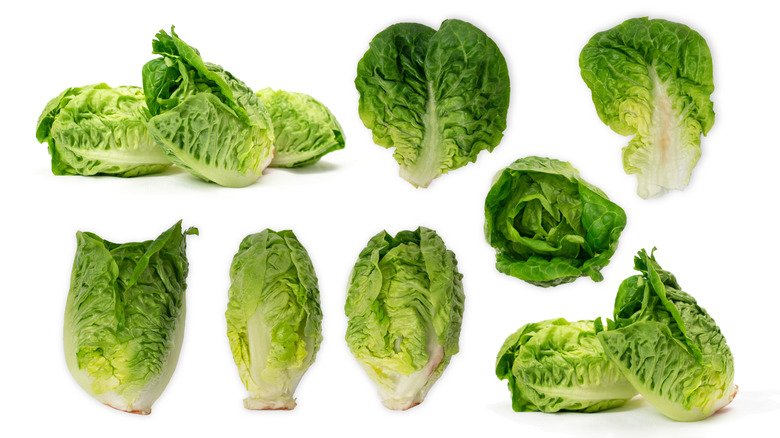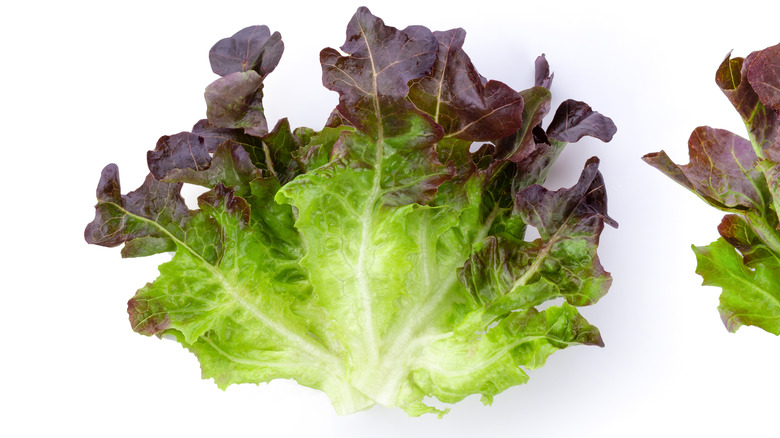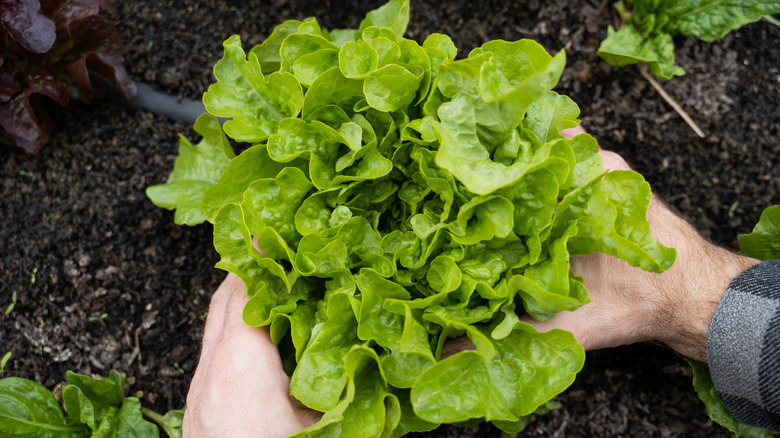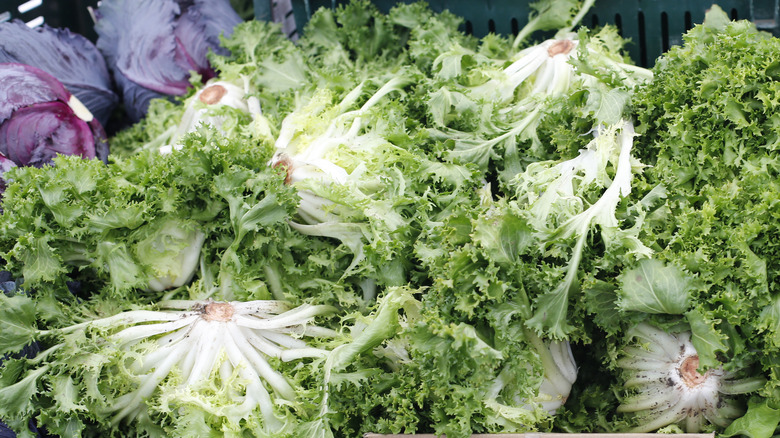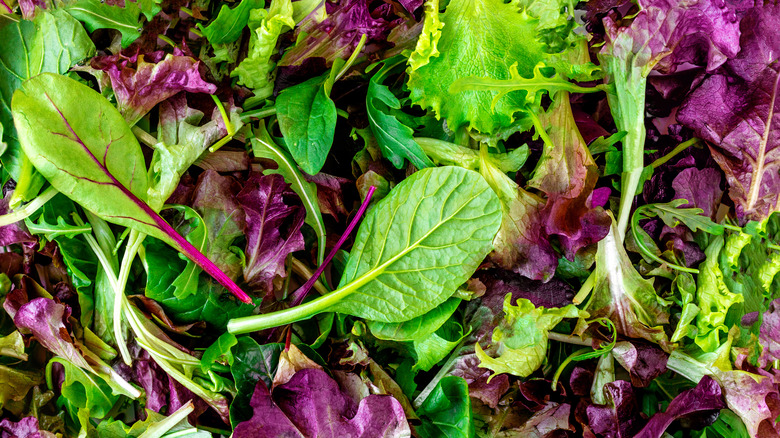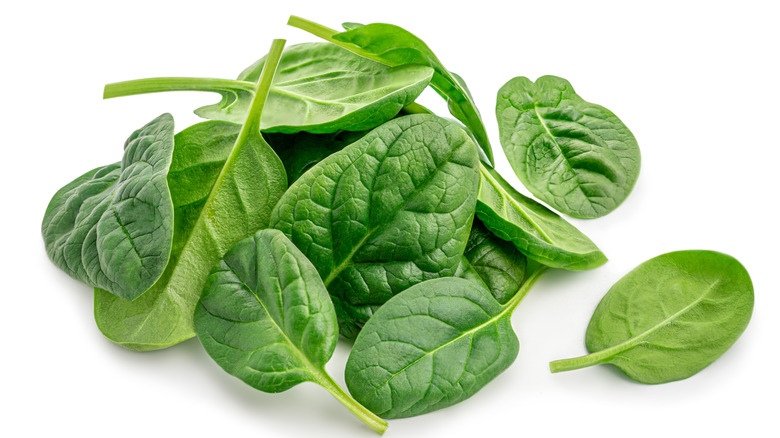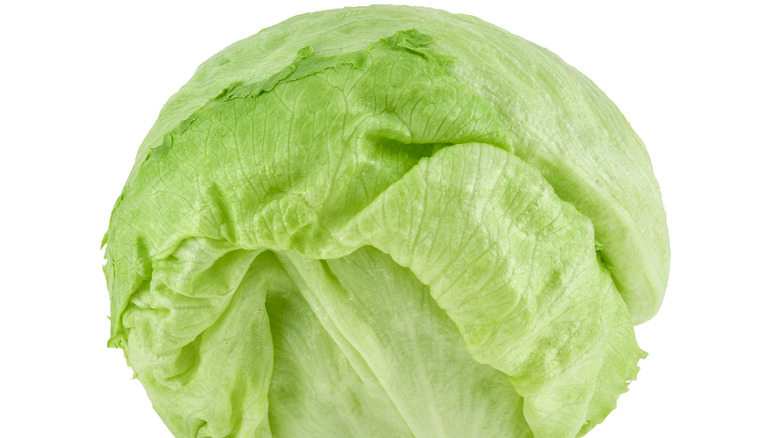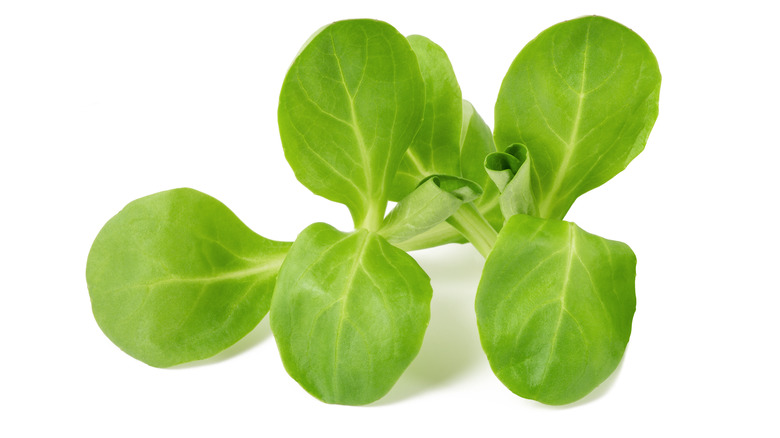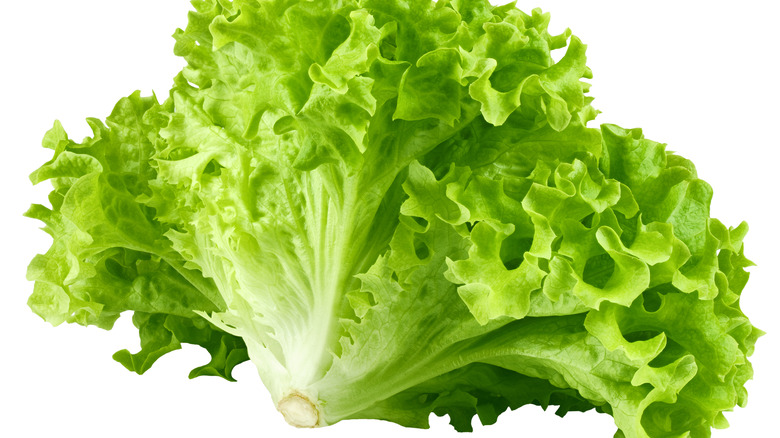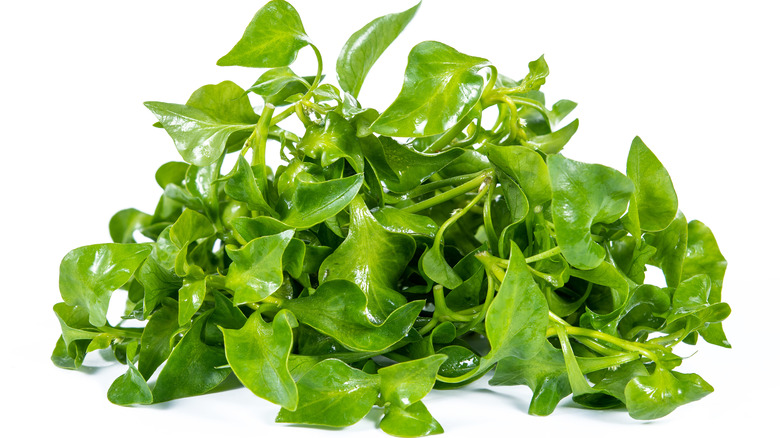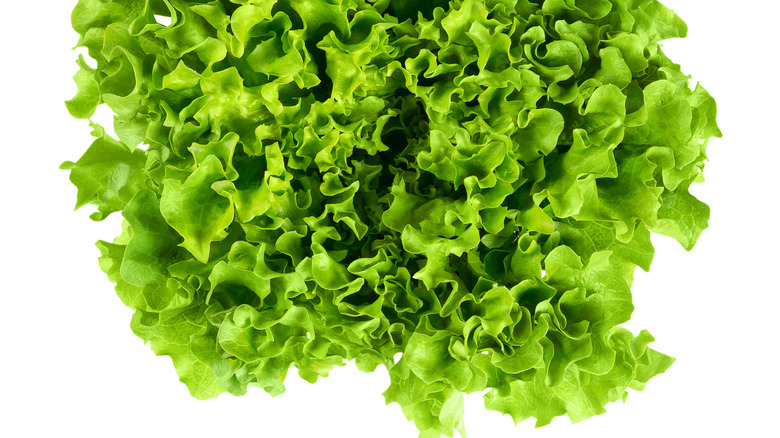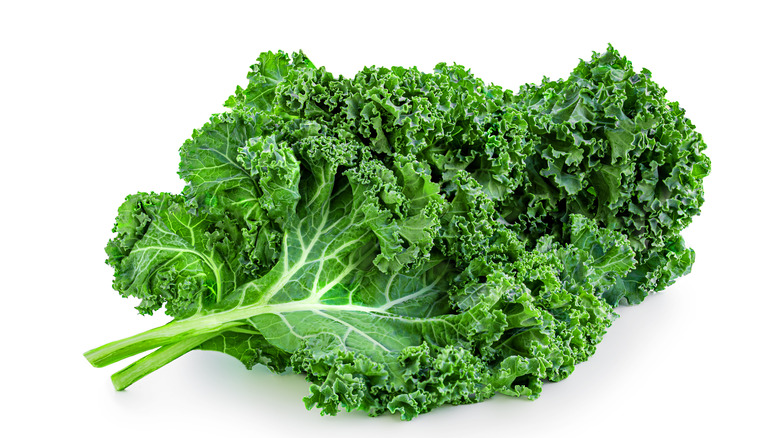17 Types Of Lettuce And What They Are Used For
It's a kitchen essential, and yet, lettuce rarely snags the starring role in any dish, whether it's serving as a bright, verdant addition to a sandwich or providing the backbone to a salad. Indeed, The leafy greens often play second fiddle to more exciting fare, from dressings (creamy or zingy) to crisp, crunchy toppings ranging from bacon to croutons. But lettuce absolutely shouldn't be overlooked, offering plenty of variety along with a host of health benefits.
Lettuces (along with similar leafy salad standards) come in different colors, ranging from all shades of green to red or even purple. They can also take a number of forms, from loose baby greens like spinach, arugula, or mesclun to tightly wound heads like Bibb and romaine. Lettuces can be crunchy and crisp like iceberg or dense and chewy like kale. They can be sweet and nutty like Boston or bitter and earthy like radicchio. Each and every one has has its own purpose and its own place to shine in the kitchen. That's why we've compiled this list highlighting popular types of lettuces plus other leafy greens and the best ways to use them.
Radicchio
Known for its distinctive purple color and pleasantly bitter flavor, radicchio is a member of the chicory family (technically a cousin of lettuce) and originally hails from Italy. While at its best in winter, radicchio is widely available all year long.
The most common iteration of this flavorful lettuce is known as Chioggia and could be mistaken for a small red cabbage, with its tightly bound leaves and spherical shape. But other varieties exist, too, including white Castelfranco or long, pale Treviso, with its purple veins. Smaller heads of radicchio will generally yield a milder flavor, while larger ones will boast a more powerful bitterness.
Radicchio can be enjoyed raw or cooked. When served raw, as in this panzanella salad, it is often paired with sweeter ingredients like oranges or apples to provide balance to its more assertive flavor. Grilled or roasted, it boasts a pleasant, mellow bitterness and a slight caramelized sweetness of its own.
Choose compact heads of radicchio with no wilted or dry outer leaves, and store in a perforated plastic bag in the fridge for up to a week.
Arugula
Arugula is known for its distinctive, peppery bite and was once hailed for its purported properties as an aphrodisiac. It originally hails from the Mediterranean and is also known as rucola, Italian cress, or rocket to the Brits. Along with kale and cabbage, arugula is a member of the cruciferous vegetable family and, as such, boasts a host of health benefits including reducing the risk of cancer and diabetes (via MedicalNewsToday).
Arugula's bold flavor means that people often pair it with other, milder greens like mesclun or romaine, or with sweeter ingredients like orange segments or fig quarters to balance out its assertiveness. Arugula is also a common pizza topping or sandwich filling to add an extra bit of bite to otherwise rich dishes. It can even be used to make pesto! As with many other more assertive greens, when cooked, arugula loses some of its powerful flavor.
Arugula is relatively delicate and should thus be stored in the crisper bin wrapped in a damp dishtowel and used within a few days of purchasing. Wash just before using to keep it from wilting before you get around to eating it!
Endive
Like radicchio, endive is a mild member of the chicory family. This white, elongated lettuce with pale green tips boasts a mildly bitter flavor and a light, nutty sweetness. Occasionally sold as Belgian endive, this lettuce cousin is light and refreshing. This is due in part to the fact that endive is made up of 95% water (part of what contributes to its reputation for being easy to digest).
Endive is considered a winter vegetable and is in season from October to April. It can either be enjoyed raw in salads, where it pair wonderfully with zippy vinaigrettes, toasted nuts, fruits like apples or citrus, as well as pungent, assertive cheeses like blue or goat. Endive can also be braised, cooked in a gratin, or baked into a savory tart. Given their natural boat-like shape, endives are also used to make fancy finger food: The leaves can be stuffed with cheese, dip, or guacamole for a pretty party hors d'oeuvre.
Store endive in the crisper bin and consume within four to five days.
Butter, Bibb, and Boston lettuce
This category of common lettuce types can seem confusing at first, so let's set the record straight: Butter lettuce is in reality an overarching category of lettuce that includes varieties like Boston lettuce and Bibb lettuce, the latter of which was developed by Kentucky lawyer John Bibb in the 1860s. What unites all of these types (unsurprisingly, given the name of the category) is their tender, "buttery" textured leaves with a mild, almost sweet flavor.
Butter lettuce originally hails from the Mediterranean, where it is generally consumed with fresh herbs and a simple vinaigrette to avoid wilting its delicate leaves. In the U.S., it has become a common low-carb alternative to taco shells or sandwich bread, wrapped around anything from Thai pork to a cheeseburger.
Butter lettuce is often sold with its roots attached, to preserve freshness. Store in the crisper wrapped in a damp towel and consume within a week of purchase.
Cos and Romaine lettuce
This crisp, crunchy lettuce originally comes from the Greek island of Cos (Kos), which lends it the name by which most folks outside the U.S. know this salad bar staple (via Food Reference). Romaine is perhaps best known as the base of Caesar salad, but the popular lettuce has a lot more tricks up its sleeve.
Thanks to its mild flavor and crisp texture, romaine is a popular salad green, featuring (aptly) in Greek salad. But it's also become more popular in recent years as a grilling staple. Indeed, romaine stands up fairly well to being cooked, as compared to some of its more delicate relatives, and grilling brings out a lovely, lightly caramelized sweetness that really pushes your salad recipe to the next level.
Romaine is usually sold as a whole head or "heart," either on its own or in packages of several heads bound in plastic. It should be unwrapped or kept in a perforated plastic bag in the crisper bin and consumed within a week.
Little Gem lettuce
A close relative of romaine, Little Gem is as sweet as its alternative name sucrine (which comes from the French for sugar) suggests. Generally harvested from spring through fall, this little lettuce is known for its balance between the crisp heart and the tender, nutty leaves.
Little Gem can be eaten much like romaine. It's crisp and fresh in salads, but it is also sturdy enough to be grilled for a lovely char. Little Gem leaves can also be used as "boats" and filled with anything from tuna salad to guacamole for a fun, low-carb finger food. It's particularly delicious dressed with Japanese orange-ginger dressing — the kind you often find at the sushi bar — which brings out the best in its sweet, nutty flavor and combination of textures soft and crisp.
Store Little Gem lettuce in a paper or perforated plastic bag in the crisper bin for up to a week.
Red oak lettuce
Red oak lettuce (or red oak leaf lettuce) is aptly named for the deep, burgundy hue of its leaves. Generally greener at the heart and redder (or even purple) at the edges, this tender lettuce is traditionally grown as a winter variety.
Red oak leaf, as other oak leaf lettuces, originally hail from France, and is known for its mellow, nutty flavor and buttery texture — perfect for enjoying with a simple vinaigrette to let its color and flavor do the talking. If you're a fan of McDonald's Southwest Salad, that might be due to the fact that red oak lettuce is thrown into the mix. The loose edges of the leaves gather into a semi-tight center, which should be carefully cleaned, especially when sourced from a farmer's market, to ensure no dirt or grit remain before you dig in.
Store this delicate lettuce in the crisper drawer: Carefully washed and dried leaves can be wrapped in a damp cloth and stored for a handful of days before enjoying.
Green oak lettuce
Red oak leaf lettuce's green counterpart is known for its frilly leaves gathered in a rosette shape and its sweet, nutty flavor. Like red oak leaf lettuce, green oak leaf lettuce originally hails from France but was likely present in Britain from the 17th century. Green varieties include Panisse.
Green oak leaf lettuce's mild flavor and balance of crisp heart and tender leaves make it the perfect, simple base for classic French salads like goat cheese salad or roasted beet salad. It also pairs well with stronger flavored lettuces like radicchio or endive to temper their more bitter aromas.
Be sure to thoroughly wash and spin dry the leaves of this lettuce, to ensure that no grit or dirt remain and that any added moisture does not cause it to wilt before you get the chance to enjoy it. Wrap the washed and dried leaves in a damp cloth and store in the crisper drawer for a handful of days before enjoying.
Frisée
Bitter frisée lettuce's name makes sense to any Francophone: French for "curly," it is yet another member of the chicory family. In fact, this lettuce is also sometimes marketed as curly endive. Green outer leaves and a pale yellow or white center are typical of this lettuce, which, like other members of the family, is typically available in the fall and winter months.
Frisée is a hardier green than most, which means it stands up to being topped with hot salad ingredients, from goat cheese toasts to the bacon lardons and poached egg typical of a salade lyonnaise. It's able to compete with more assertive flavors like blue or goat cheeses and sherry vinaigrette. Due to its bitter flavor (and expense), frisée is also often paired with other milder greens, including spring mix or mesclun.
Store frisée in the fridge in an open plastic bag for no more than two or three days before enjoying.
Mesclun greens
This one's a bit of a cop-out: after all, mesclun isn't so much a variety of lettuce as it is a mix of baby leaves from a variety of different lettuce types. Also sometimes known as spring mix, it can contain anything from arugula to baby red and green lettuces to baby spinach to young chard or beet greens. First referenced in Nice in the 1970s, mesclun has become a popular option in the U.S. since Alice Waters first introduced it to the menu at Chez Panisse. Today, it is beloved across the country — and the world — thanks to its tender texture and combination of colors and flavors.
Depending on what greens are in your mix, mesclun may tend towards nutty, earthy, bitter, or peppery flavors. Some mixes even contain herbs in and among the lettuces. Dressed with a simple vinaigrette, there's no easier side dish!
The baby greens that make up mesclun mixes tend to have a short shelf life, so use your mesclun quickly — within a few days of purchase. Don't wash it until ready to use to keep it from wilting; just keep it moist with a damp paper towel, and if it is sold in a clam box or bag, be sure to perforate it so that it can breathe and condensation does not build up, which may make it wilt.
Baby spinach
Baby spinach is a popular, nutrient-dense base for salads and more. Sold in the early stages of growth — usually between 15 and 35 days after planting — the immature greens boast a sweeter flavor and more tender texture than its older, earthier counterpart.
Baby spinach can be enjoyed in myriad ways: as a salad base, blended into vibrant green smoothies or juices, or simply sautéed like regular spinach. It can be added to pasta sauces or omelets, and it's welcome in quiches or savory tarts. When used as a salad green, baby spinach's robust flavor makes it the perfect base for more assertive flavors like sweet candied walnuts or pungent blue cheese. It also stands up well to the heat of warm salads with bacon or boiled eggs.
Be sure to pat your spinach dry before storing, as its high moisture content can make it go slimy within a matter of days. Slip a dry paper towel into the bag or box to soak up any excess moisture, and consume within five days.
Iceberg lettuce
This old stalwart of steakhouses has suffered an unfortunate rep of late due to its lack of nutrients as compared to heartier greens like spinach or kale. But iceberg lettuce has its place in the kitchen! This crisp lettuce variety first rose to fame in the 1920s, when it was cultivated in California and shipped across the country on ice. Known above all for its crisp texture and high water content, iceberg is a welcome base for a classic wedge salad with blue cheese dressing and bacon, but also for a crunchy Cobb salad. Its big, mild, crisp leaves can even be used as a low-carb alternative to a tortilla in a wrap or taco, or to a burger bun for a paleo cheeseburger.
Nutrient-wise, let's be honest: iceberg is mostly water. But there's some fiber in there, too!
Store iceberg whole in the fridge, and slice or chop at the last minute to prevent oxidizing. Consume within a few days.
Mâche lettuce
Known by a variety of names including mâche, lamb's lettuce, doucette, and even corn salad (a nickname that comes from its tendency to grow wild in corn fields), this tender, sweet lettuce is a favorite in France, from whence it hails.
Mâche is often sold in small rosettes — sometimes with the roots attached to maintain freshness. There are over 200 different varieties of mâche and the lettuce is renowned for its nutty flavor and tender texture. Mâche is typically eaten with a light dressing to let its flavor shine. Given its expense, it can also be paired with other baby greens, like baby spinach, arugula, or mesclun.
Mâche is typically harvested in late winter or early spring. It should be stored in the fridge wrapped in a damp towel and eaten within two days of purchase, as it has a tendency to wilt quickly.
Coral lettuce
Coral lettuce, also known as lollo bionda or, simply, green leaf lettuce, is a lettuce with tight, curly, green leaves. Tender in texture with the slightest bitter edge, this lettuce is lovely when dressed in a simple vinaigrette. As an added bonus, those tight curls easily trap your dressing, lending more flavor to every bite.
The big leaves of coral lettuce make it the perfect stand-in for tortillas as a low-carb wrap alternative. A rarer red version known as lollo rossa can sometimes be found, and it's even more striking on the plate.
Store coral lettuce in an unsealed bag in the fridge, and consume within three to four days of purchase. Be sure to wash it well to remove any grit that can get trapped in its curls or at its core. Any remaining leaves that remain loose after washing should be consumed within a day or two, lest they wilt.
Watercress
Watercress, sometimes simply called cress, is a member of the brassica family, along with kale, cabbage, and arugula. Known for its peppery flavor, this green is rich in nutrients as well as flavor. It was first cultivated in the UK in the 18th century in watery beds that lend it its common name.
Watercress is particularly beloved in the UK, where it is a staple, notably, of egg-and-cress tea time sandwiches. In a salad, watercress is often paired with milder leaves to balance out its more pungent, bitter aromas, as well as with sweeter ingredients like orange segments. Watercress can also be cooked like spinach and served in omelets, on pizza, or in a soup.
Watercress is best between April and September. Highly perishable, it should be stored in a perforated bag and eaten within a few days of purchase. The BBC also recommends keeping it roots-down in water — like cut flowers — and covering the leaves with a plastic bag to extend its shelf life slightly.
Batavia lettuce
Also known as looseleaf lettuce or French lettuce, batavia lettuce is a crinkled variety with wavy leaves that can range from bright green to reddish brown in color, depending on the variety. Green varieties include Nevada, Concept, Sierra, and Muir. The crisp, summer lettuce tends to be even more flavorful the greener it is.
Given its nickname, it's no surprise that this lettuce is particularly popular in France. Indeed, it is the most common lettuce enjoyed throughout France, making the perfect base for anything from a simple green salad with a vinaigrette to a hearty niçoise salad with tuna, tomatoes, and olives. Its earthy, mild flavor pairs particularly well with snappy vinaigrettes with a kick of acidity.
Batavia lettuce should be stored in the crisper drawer, where it will keep for up to four days. Wash it well just before enjoying to remove any grit that can become trapped at its core, and spin it dry before dressing.
Kale
Kale has become the pet leafy green of many health-conscious foodies due to its impressive nutritional profile. Indeed, kale, which is a member of the cabbage family (and is sometimes even known as leaf cabbage or leafy cabbage) is rich in vitamins, minerals, and fiber.
Several different kale varieties exist, of which the most common are curly green kale and lacinato or Tuscan kale, also sometimes called dinosaur kale. Red Russian kale boasts a purple color and a slightly more assertive bitter flavor than green varieties.
While some opt to cook their kale, either sautéed, stewed, or fried as chips, it is also delicious raw in salads. Given its earthy aromas, it stands up well to flavorsome ingredients like fruits, nuts, and cheese. Many kale salad recipes say to "massage" the dressing into the kale, which helps to break down its more fibrous texture. Bobby Flay also suggests tenderizing kale with a knife for the perfect kale salad.
Kale is available year-round but is best in fall and winter (via The BBC). Store in a perforated bag in the fridge and consume within a few days; it may not wilt as quickly as its more delicate counterparts, but it will get more bitter with time.
